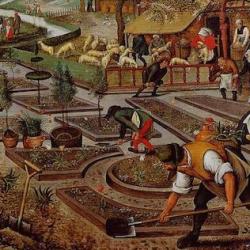Challenging both the “traditional” social interpretations of English politics in the 17th century (Stone, Hill) and also the Revisionists who dismiss social causes, Robert Brenner ( Merchants and Revolution: Commercial Change, Political Conflict, and London’s Overseas Traders, 1550-1653 , p. 650) offers this summary of the shift of politics and society in the transition from feudalism to capitalism: “What the transition from feudalism to capitalism on the land essentially amounted to was the transformation of the dominant class from one whose members depended economically, in the last analysis, on their juridical powers and their direct exercise of force over and against a peasantry that possessed its means of subsistence, into a dominant class whose members, having ceded direct access to the means of coercion, depended economically merely on their absolute ownership of landed property and contractual relations with free, market-dependent commercial tenants (who increasingly hired wageworkers), defended by a state that had come to monopolize force.”
As this summary indicates, this involved massive political as well as social and economic change, but the primary political change in Brenner’s explanation is that the state secured a monopoly of the means of coercion that had once been distributed throughout the society’s aristocracy. That is, the transition to capitalism involved an increase in the state’s monopoly of power. Brenner sees the shift as partly caused by new economic developments: “capitalist development helped precipitate the emergence of a new form of state, to which the relationships of capitalist landlords and of the patrimonial monarchy were essentially ambiguous.” Ambiguous enough to be “the source of immanent fundamental conflict” (p. 651).
Whatever this new state was, though, it was not a state that refrained from directing the new economic developments. Brenner gives numerous examples of the government protecting and promoting new industries and forms of trade.
“Throughout the sixteenth and early seventeenth centuries, the merchants of London secured their profits as much through collective political initiative and organization as through individual economic enterprise. In almost every case, they founded their trades on government privileges that provided the basis for monopoly companies and the close regulation of commerce. Trade by a government-chartered, regulated company the long-established norm in England. And it had a good and sufficient rationale in the complementary needs of the larger overseas merchants and the monarchy” (p. 54).
Traders faced a number of issues. They had to be able to buy cheap and sell dear. But there was a built-in tendency “toward overtrading,” which would occur if “too many merchants entered the trade or if those merchants already active shipped too many goods.” Competition would increase, more goods would become available, and prices would fall, leading to “declining or disappearing profit margins.” On the other hand, they needed to control demand so as to prevent rising prices that would make their goods impossible to sell. The solution was to control the market through monopoly: “The merchants thus sought government-backed monopolies in order to restrict trade to members of their companies and to bar those who were not exclusively overseas traders. On this basis, they sought to regulate the shipments of the company traders, with the goal of manipulating markets for purchases as well as for sales” (p. 54).
The Crown had all kinds of reasons to grant such privileges to selected companies. The Crown had always had some difficulty collecting taxes, and this difficulty became even worse during the Tudor and Stuart eras. Henry VIII’s wars were expensive, and the government needed revenue. Enter the merchants: “A prosperous merchant community could offer an unrivaled source of financial support. Merchants could grant loans to the monarchy and pay taxes on trade. They would, presumably, be more able and willing to do so to the extent that the monarchy granted commercial privileges that secured and enhanced their profits” (p. 54).
The Merchant Adventurers involved in the cloth trade had secured royal privileges throughout the Middle Ages, but the various crises of the late sixteenth century made these even more necessary in their view. The need was mutual. The Crown took out loans from the city of London, dominated by merchants, and they paid their creditors not only in loan repayments but in privileges: “Stepped-up royal protection of trade was designed to compensate the merchants for their financial contributions, thereby encouraging their willingness, and increasing their ability, to pay . . . . The Crown helped the leading Merchant Adventurers defeat their opponents outside the company . . . . The powerful Hanse of German merchants was deprived of its trading privileges, while the Italian and Flemish merchants were essentially confined to their import operations . . . . The Crown created the conditions that made it possible to regulate competition within the company itself” by supporting the Company’s restrictions on entry into their trade. In particular, “The Crown assisted . . . by crushing a bid by the merchants who had entered the company by paying a fee . . . to gain a status equal to that of those admitted by apprenticeship . . . and a greater role in directly company affairs” (pp. 56-57).
The trade of the Adventurers was of course affected by events outside the control of the monarchy, and other factors led to a decline of their fortunes. But under the Crown’s protection, the Adventurers were able to control the market. They radically diminished foreign involvement in the market, controlled the number of clothes sold, and were able to divvy up the industry’s income among a far smaller number of merchants: “In 1606, 210 merchants shipped cloth to the Adventurers’ privileged areas, dividing among themselves a trade of some 101,000 cloths worth close to 800,000 pounds. In 1614, 182 merchants shipped clothes to the Adventurers’ privileged areas, sharing a trade of some 99,000 clothes also worth close to 800,000 pounds.” As a result, “while total London exports essentially stagnated between the late 1550s and the turn of the century . . . London denizen cloth exports grew noticeably over that period” (pp. 57-58).
Brenner summarizes: “The Merchant Adventurers thus maintained their prosperity in the face of the relative sluggishness of their trade essentially by developing a much more intimate relationship with the crown. The informal system by which the Adventurers made a significantly deeper financial and political commitment to the Crown, receiving in exchange powerful protection of their trade, succeeded admirably from the viewpoint of both parties, at least for a time. It served as a morel both for Crown-merchant relations and for the operation of overseas commerce by privileged companies throughout the pre-Civil War period” (p. 59).










